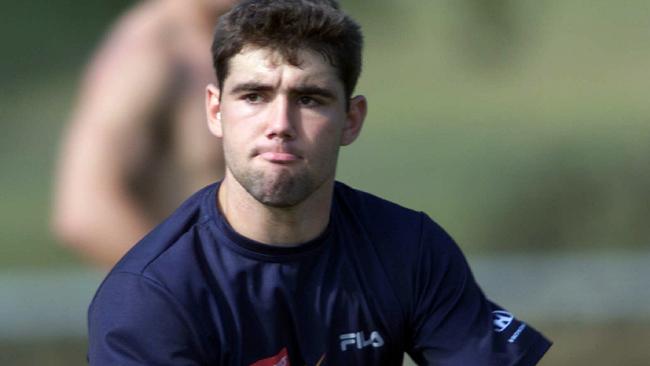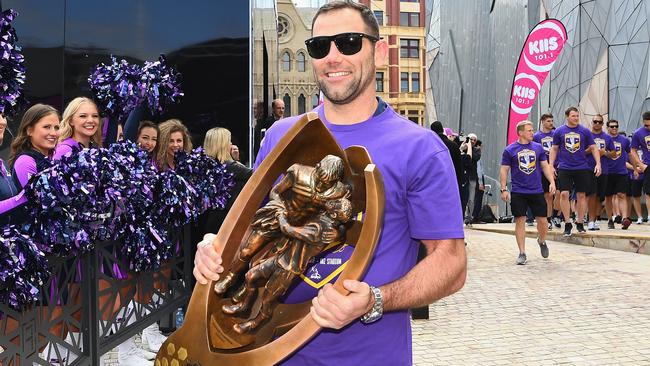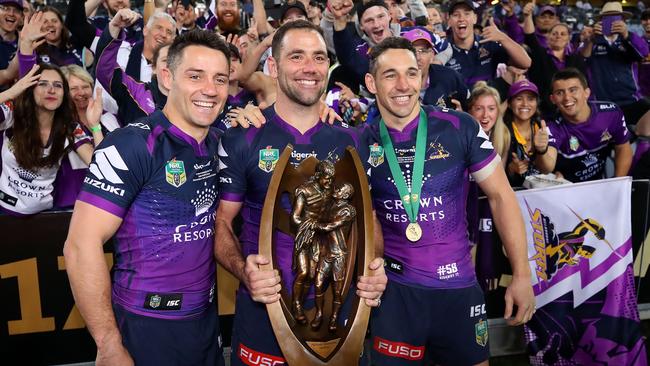The humble beginnings of Cameron Smith’s illustrious NRL career
It was buried down the bottom of a yarn in a Melbourne broadsheet 17 years ago - a young halfback named Cameron Smith was to make his NRL debut.
JOURNEY: The twin paths of Smith and Marshall
MIRACLE: Inside a moment of Origin history
The local broadsheet in Melbourne chronicled the arrival of rugby league’s greatest servant as a gamble.
And it was buried in the 22nd paragraph of a 29-paragraph page-lead.
“The Storm flew 18-year-old Norths hooker Cameron Smith to Melbourne on Tuesday night, and (Storm coach) Mark Murray indicated yesterday that he would gamble on the rookie at halfback on Saturday,’’ The Age reported on April 11, 2002.
Not even ‘Muppet’ Murray’s insight — which appears now to be a clear breaking of the NRL coaches golden rule, which states; one should never talk-up a debutant — convinced local sports editor’s to re-jig their reporter’s copy.
“He’s got a kicking game and a passing game, and he was the Junior Kangaroos’ hooker last year, so he’s got a lot of talent and class on his side as a youngster,” Murray told the one or two scribes who covered the Storm in the early 2000s.

Smith’s NRL debut was barely news.
Yet, more than 1600km away, a proud Smith family were reaching for their boy’s scrapbook.
On a wall inside Smith’s parents home in Logan, just south of Brisbane, a Storm jersey with No.18, hangs in a frame and encased in glass. The jersey means as much to Smith and his family as his 52 Australian or 42 Queensland Origin jumpers do.
That first purple jersey, with it’s thick yellow cotton collar, is the jumper a boy who wore his footy boots to bed could only dream of.
It’s the NRL jersey Smith pulled on in his imagination, before using the family’s outdoor furniture to practice his pinpoint kicking.
In his mind, Smith was 20 metres out from the opposition tryline, when kick after kick, he would dribble his footy across the backyard, aiming for a hole under the hotplate of the family barbecue.
Of his two NRL premierships, two Dally M player of the year awards, Golden Boot and seven Dally M hooker of the year trophies, it’s that first grade jersey which Smith chased as he honed his tackling technique on Buster, the family’s pet german shepherd.

And most obviously, the jersey with 2002 major sponsor Adecco stamped across the front, represents the day Smith’s trek began to a record 400 NRL games, which he will achieve against archrivals Cronulla at AAMI Park.
Without a halfback in the club after star playmaker Matt Orford was injured and then back-up half Marty Turner was involved in a car accident, Smith received a phone call just three days before Melbourne’s round-five clash with premiership heavyweights Canterbury at Olympic Park.
“I was travelling back from training at Norths Devils when I got the phone call,’’ Smith told The Saturday Telegraph.
“They (Storm officials) told me to get to Melbourne, you’re going to be playing first grade this weekend.
“I deadset flew down, it was a bit of whirlwind, and had one main training session and then a short captain’s run.
“The game day was as nervous as I ever have been for a footy game.’’
Smith was just 18 and the greatest hooker in rugby league history made his debut at halfback.
In the dank Olympic Park dressing room on a typically overcast Melbourne Saturday afternoon, he warmed-up with seasoned first-graders and Internationals.

Kangaroos prop Robbie Kearns was the captain, Kiwi international and current Warriors coach Stephen Kearney was in the backrow while Smith was paired in the halves with NSW Origin and Australian representative Scott Hill.
And ironically, Henry Perenara — NRL referee and the senior review official in the bunker for tonight’s clash — was named at lock on the day Smith made his debut.
“In those couple of training sessions that I had, guys like Matt Geyer and Stephen Kearney, Scott Hill and Robbie Kearns, just talking to me about my role and their expectation of me,’’ Smith said.
“They reassured me that they believed in me and they were there to support me. Sometimes you can be overawed when you come into a first grade system and all these superstars of the game feel like they’re bigger than what you are and they don’t give you the time of day.
“But these guys were extremely approachable and who had achieved a lot in their own right. Here they were looking after a little 18-year old.’’
In front of his parents, closet family and friends, including his now-wife Barbara, Smith’s welcome to the big time was against a Bulldogs side loaded with guns. Smith’s first NRL game was a 22-6 loss.
“Unfortunately that day we came up against one of the best teams in the competition, the Bulldogs,’’ Smith said.
“They were a pack with stars, Mark O’Meley, Steve Price, Willie Mason and then they had Nigel Vagana, Braith Anasta...just these ridiculous players that you never thought you’d get an opportunity to play alongside and all of sudden your there.
“Even though we got beaten, it was just a really memorable moment.’’
Smith played the following week, gifting him two unforgettable experiences in the NRL as a teenager.
Yet it would be the last time during his entire 18-year career so far that Smith would play anything less than 20-games in a season.
The virtually unheard of statistic to play on average 23 games every year - not including representative matches - since his debut, speaks directly to his record.
Be it his undeniable fortune to escape serious injury or lengthy suspensions, the extraordinary durability of the game’s greatest hooker has left commentators baffled as to how, the most influential player on a footy field over the past decade, has escaped capital punishment from the opposition.
And on those rare days that Smith is targeted by forward’s 25kg heavier, how, given his modest size - which Kearns enjoys describing as “a body without shoulders” - that he’s able to average 36 tackles per game and then trundle back out onto the field, the following week.
The transformation of the modern-day football has moved rapidly since Smith’s debut.

In season, not a day goes by that a pro-footballer isn’t being measured, weighed, timed, treated, rested or fed.
Sports science has turned footballers into racehorses, with forward’s and backs trained specific to their requirements, just as sprinters are coaxed differently to two-milers.
On a night where he will be feted in justified praise, Smith nods knowingly that today’s modern medicine and sports science, is crucial to his incredible achievement.
“Back when I started in the NRL, there wasn’t as much detail as far as our training and recovery goes,’’ Smith said.
“It was basic. Our ice baths were pretty much wheelie bins with some water and some ice.
“Then we upgraded from wheelie bins - I still remember this - to two iron bath tubs.
“They made a bit of framework out of timber so it looked liked a small little deck with two bath tubs sunk into it.
“We’d finish our training sessions and start doing ice baths there, outside in the middle of winter in Melbourne.
“So we’ve come a long way since then.
“As far as the video, and analysis of opposition, when Craig first started in 2003 he was big on that then.

“So that part for me, hasn’t been a huge change, we’ve always done a lot of video on ourselves in review and also analysing opposition as well.
“The biggest change for me is really, the science behind training now.
“They target certain distances in training sessions now and you’ve got targets for maximum speeds that you want to reach and how long you want to run at that speed for, to maximise whatever it is your trying to target in those sessions.
“Back when I first started it was ‘hey boys, we’re out here until we get this training session right.
“And when it came time for conditioning it was run until you can’t run anymore.
“There’s a little bit more thinking about it now. More planning, more strategy.’’
Maybe the 36-year-old, who ran so much in his backyard as a boy that he wore the grass down to dry dirt, is being modest.
But when NRL CEO Todd Greenberg presents one of the game’s greatest champions with a Waterford crystal football after the full-time siren tonight, Smith will do so convinced that he won’t be the last NRL player to achieve the extraordinary milestone.
“I’ve got not doubt that the improvements of training loads and management of injuries, that’s played a part in my longevity,’’ Smith said.
“It certainly has and it has across the board.
“Because you see more often then ever now, that guys are reaching 300 games. The 300-mark was once considered untouchable.
“The 300-game mark is now what the 200-game mark used to be.
“Me being the first one to reach 400, whose to say another three or four won’t do it over the next decade.
“Hopefully that happens because it’s great for our game.’’



